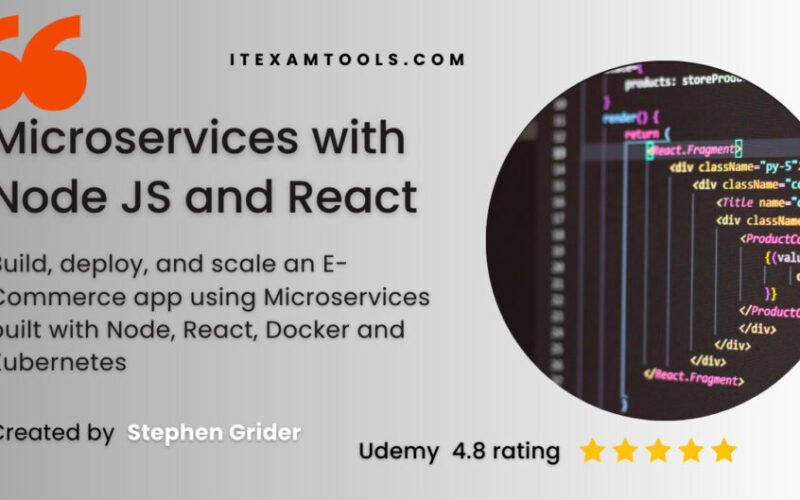Smart Phone Remote Controller ● Widespread Compatibility: Your smartphone can function effectively with the standard connector that is frequently used to replace iOS cellphones.● Plug and Play: Your smartphone may become an…
Microservices with Node JS and React

Build, deploy, and scale an E-Commerce app using Microservices built with Node, React, Docker and Kubernetes
Title: Mastering Microservices with Node.js and React: Turbocharge Your IT Career!
In today’s fast-paced digital landscape, the IT industry is constantly evolving, and staying ahead of the curve is essential for a successful career. Enter the world of microservices, where modular, scalable, and maintainable architecture reigns supreme. If you’re an aspiring IT professional looking to supercharge your career prospects, the Microservices with Node.js and React course on Udemy is your golden ticket to success.

Look what you are going to learn out of this course!
1. Architect Large, Scalable Apps with Microservices
Microservices have revolutionized how we build and deploy applications. In this comprehensive course, you’ll gain a deep understanding of microservices architecture and learn how to design large, scalable apps using a collection of interconnected microservices. Dive into the principles of decoupling, modularity, and service independence, and witness firsthand how this architecture can transform the way you approach software development.
2. Deploy a Multi-Service App with Docker and Kubernetes
Learning how to deploy applications to the cloud is a crucial skill for any IT professional. This course guides you through the process of deploying a multi-service app to the cloud using Docker and Kubernetes. You’ll master containerization, orchestration, and scaling, equipping you with the knowledge to efficiently manage and scale your microservices-based applications.
3. Solve Concurrency Issues in a Distributed Systems Environment
The world of microservices comes with its own set of challenges, and concurrency is a significant one. Gain the expertise to navigate and resolve concurrency issues within a distributed systems environment. With hands-on exercises and real-world examples, you’ll learn strategies to handle complex scenarios and ensure seamless communication between microservices.
4. Leverage Your JavaScript Skills to Build a Complex Web App
JavaScript is the backbone of modern web development, and this course helps you harness its power to build a complex web application. Through practical coding sessions, you’ll strengthen your JavaScript skills while constructing a feature-rich app that showcases the potential of microservices architecture.
5. Build a Server-Side Rendered React App
Server-side rendering (SSR) enhances performance and user experience. Discover how to create a Server-Side Rendered React App that pulls data from your microservices. By the end of this section, you’ll have a solid grasp of rendering techniques that can significantly elevate your app’s performance.
6. Understand How Enterprise Companies Design Their Infrastructure
Peek behind the curtains of enterprise-level companies and gain insights into how they design their intricate infrastructure. Uncover best practices, strategies, and methodologies employed by industry leaders to create robust, scalable, and fault-tolerant microservices-based systems.
7. Share Reusable Code with Custom NPM Packages
Efficiency is key in software development. Learn how to share reusable code between multiple Express servers using custom NPM packages. This skill not only streamlines your development process but also promotes code consistency and collaboration within your team.
8. Write Comprehensive Tests for Reliable Microservices
Reliability is paramount in microservices-based applications. Dive into the art of writing comprehensive tests to ensure each service functions flawlessly as designed. Gain confidence in your codebase by implementing testing strategies that guarantee the robustness of your application.
9. Communicate Data Between Services Using an Event Bus
Efficient communication between them is essential for seamless functionality. Master the concept of an event bus and discover how to use it to facilitate lightning-fast data exchange between services. Witness the power of event-driven architecture in action.
10. Write Production-Level Code: No Cutting Corners!
In the world of microservices, there’s no room for shortcuts. Develop the mindset and skills needed to write nothing but production-level code. Embrace best practices, coding standards, and industry norms to create software that’s reliable, maintainable, and ready for the real world.
Conclusion: Your IT Career Booster
As you embark on your journey toward a rewarding IT career, the Microservices with Node.js and React course stands as a beacon of opportunity. By mastering microservices architecture, cloud deployment, concurrency management, and more, you’ll position yourself at the forefront of modern software development. Equip yourself with the tools to build scalable, resilient, and high-performance applications that meet the demands of today’s dynamic industry.
Investing in your education is an investment in your future. By enrolling in this comprehensive Udemy course, you’re not just learning new skills – you’re opening doors to a world of possibilities. Don’t miss out on the chance to elevate your IT career to new heights. Enroll in the Microservices with Node.js and React course today and unlock your potential like never before. Your future self will thank you.

let’s incorporate some practical code examples to emphasize the key learning points from the Microservices with Node.js and React course:
1. Architect Large, Scalable Apps with Microservices
javascript// Sample Microservice - Orders Service const express = require('express'); const app = express(); const port = 3001; app.get('/orders', (req, res) => { // Fetch and return orders data from database const orders = [{ id: 1, product: 'Widget' }, { id: 2, product: 'Gadget' }]; res.json(orders); }); app.listen(port, () => { console.log(`Orders Service listening at http://localhost:${port}`); });
2. Deploy a Multi-Service App with Docker and Kubernetes
Dockerfile for Orders Service:
dockerfile# Dockerfile for Orders Service FROM node:14 WORKDIR /app COPY package*.json ./ RUN npm install COPY . . EXPOSE 3001 CMD ["node", "app.js"]
Kubernetes Deployment:
yamlpiVersion: apps/v1 kind: Deployment metadata: name: orders-deployment spec: replicas: 3 selector: matchLabels: app: orders template: metadata: labels: app: orders spec: containers: - name: orders image: orders-service:latest ports: - containerPort: 3001
5. Build a Server-Side Rendered React App
javascript/ React Component for Server-Side Rendering import React from 'react'; import { renderToString } from 'react-dom/server'; import App from './App'; // Your main App component const serverRenderer = (req, res) => { const app = renderToString(<App />); res.send(` <!DOCTYPE html> <html> <head> <title>Server-Side Rendered App</title> </head> <body> <div id="root">${app}</div> <script src="client-bundle.js"></script> </body> </html> `); }; export default serverRenderer;
7. Share Reusable Code with Custom NPM Packages
Creating a Custom NPM Package:
- Create a new directory for your package.
- Inside the directory, create a file named
package.jsonwith appropriate details. - Write your library code in separate files, like
utils.js. - Export functions or classes from
utils.js.
Example usage in Express Server:
javascriptconst express = require('express'); const app = express(); const utils = require('your-custom-package'); // Importing your custom NPM package app.get('/', (req, res) => { const result = utils.someUtilityFunction(); res.send(`Result from custom package: ${result}`); }); app.listen(3000, () => { console.log('Server is running on port 3000'); });
9. Communicate Data Between Services Using an Event Bus
Event Bus Implementation (Simplified):
javascriptclass EventBus { constructor() { this.events = {}; } on(event, callback) { if (!this.events[event]) { this.events[event] = []; } this.events[event].push(callback); } emit(event, data) { if (this.events[event]) { this.events[event].forEach(callback => callback(data)); } } } // Usage const eventBus = new EventBus(); // In one service eventBus.emit('orderCreated', { id: 123, product: 'New Widget' }); // In another service eventBus.on('orderCreated', data => { console.log(`Received orderCreated event: ${data.id} - ${data.product}`); });
These practical code examples provide a glimpse into the hands-on experience you’ll gain from the Microservices with Node.js and React course on Udemy. Through real-world scenarios and guided exercises, you’ll not only understand the concepts deeply but also have the skills to implement them effectively in your projects, ensuring a solid foundation for your IT career.

here are 20 multiple-choice questions related to the topics covered in the Microservices with Node.js and React course:
1. What is the main advantage of using a microservices architecture? a) Monolithic codebase b) Tight coupling between services c) Scalability and modularity d) Limited deployment options
Answer: c) Scalability and modularity
2. Which technology is commonly used for containerization in microservices applications? a) VirtualBox b) Docker c) Vagrant d) Ansible
Answer: b) Docker
3. What is Kubernetes primarily used for in microservices deployment? a) Code version control b) Load balancing c) Front-end development d) Database management
Answer: b) Load balancing
4. Server-side rendering (SSR) is particularly beneficial for: a) Faster client-side navigation b) Improved server security c) Enabling code splitting d) Enhancing SEO and performance
Answer: d) Enhancing SEO and performance
5. What is an Event Bus used for in microservices communication? a) Sending HTTP requests b) Database synchronization c) Handling concurrency d) Facilitating data exchange between services
Answer: d) Facilitating data exchange between services
6. Which aspect of microservices architecture promotes independent development and deployment? a) Tight coupling b) Monolithic structure c) Shared databases d) Service autonomy
Answer: d) Service autonomy
7. Which tool is commonly used for creating and managing custom NPM packages? a) Yarn b) Node Package Manager (NPM) c) Express.js d) Babel
Answer: b) Node Package Manager (NPM)
8. What is the primary role of a Dockerfile in a microservices environment? a) Database management b) Container orchestration c) Defining a service’s image and dependencies d) Load balancing
Answer: c) Defining a service’s image and dependencies
9. Which testing approach helps ensure the functionality and reliability of individual microservices? a) Unit testing b) End-to-end testing c) Acceptance testing d) Continuous integration
Answer: a) Unit testing
10. What is the main purpose of an event-driven architecture in microservices? a) Data encryption b) User authentication c) Efficient communication between services d) Debugging code
**Answer: c) Efficient communication between services**
11. In microservices architecture, what is the term for breaking down a large application into smaller, manageable services? a) Macroservices b) Monoliths c) Decoupling d) Microsegmentation
**Answer: a) Macroservices**
12. Which of the following is NOT a benefit of microservices architecture? a) Improved fault isolation b) Simplified deployment c) Centralized data storage d) Scalability
**Answer: c) Centralized data storage**
13. Which tool is commonly used to automate the deployment, scaling, and management of containerized applications? a) Docker b) Git c) Kubernetes d) Jenkins
Answer: c) Kubernetes**
14. What is the primary goal of a Server-Side Rendered (SSR) React app? a) Enhance client-side navigation b) Optimize server performance c) Improve user authentication d) Boost SEO and initial page load speed
answer: d) Boost SEO and initial page load speed**
15. What does an Event Bus enable in a microservices architecture? a) Real-time gaming b) Fast CPU processing c) Efficient communication between services d) High-definition video streaming
Answer: c) Efficient communication between services**
16. Which development principle is emphasized by microservices architecture? a) Tight coupling b) Monolithic design c) Code reusability d) Single-tier architecture
Answer: c) Code reusability**
17. What is a benefit of sharing reusable code using custom NPM packages in microservices? a) Increases service coupling b) Decreases deployment flexibility c) Enhances code consistency and collaboration d) Slows down development speed
*Answer: c) Enhances code consistency and collaboration**
18. What is the primary focus of writing comprehensive tests for microservices? a) Debugging the entire application b) Ensuring each service works as designed c) Load testing the front-end components d) Generating documentation
*Answer: b) Ensuring each service works as designed**
19. In microservices, what is the term for the ability of a service to operate independently and autonomously? a) Service coupling b) Service dependence c) Service autonomy d) Service orchestration
Answer: c) Service autonomy
20. Which factor distinguishes microservices from a monolithic architecture? a) Limited scalability b) Shared codebase and database c) Reduced deployment complexity d) Centralized management
**Answer: b) Shared codebase and database**








